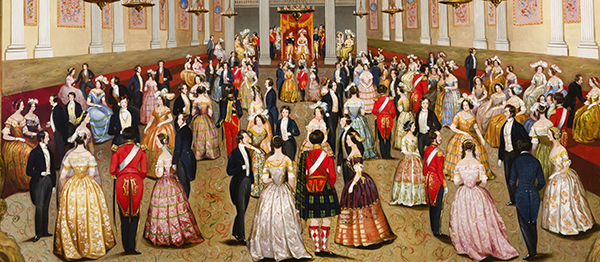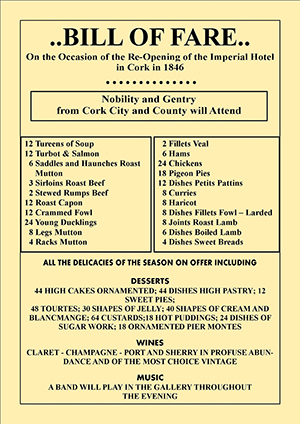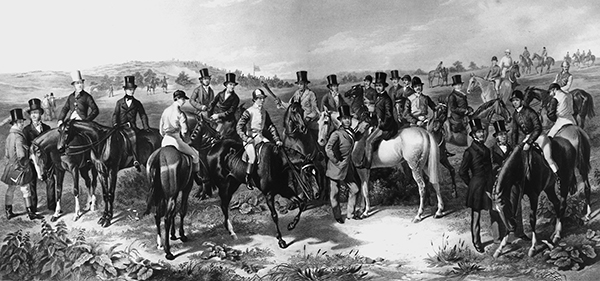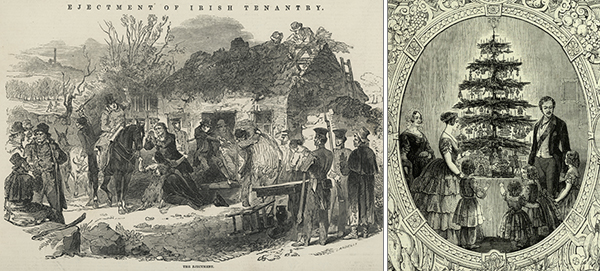‘Every delicacy of the season’—conspicuous consumption during the Great Hunger
Published in 18th-19th Century Social Perspectives, Features, Issue 3 (May/June 2018), Volume 26Regattas and horse-racing, flower shows and fashion, balls and banquets where the tables groaned under the weight of the sumptuous repast are the unlikely topics of this article related to the years of the Great Hunger.
By Edmund O’Riordan
Regattas
According to the official report in the Cork Examiner in September 1846, the assemblage of ‘rank and fashion’ at the recent Glandore Regatta in West Cork far exceeded any former occasion:
‘The picturesque scenery of this unrivalled harbour, which is at all times so much to be admired, presented, on the days of the regatta, an appearance gay and animated beyond description’.
A number of large yachts from the Royal Cork Yacht Club and an immense number of smaller boats filled the bay. In another, altogether different, report on the same event, however, the Examiner correspondent, Jeremiah O’Callaghan, wrote that he sought out the ragged, hungry and sunburnt, ‘poverty stricken serfs’ from the famine relief works, who had been directed to remain idle and out of sight lest their appearance upset the upper-class visitors to the regatta. O’Callaghan recounted how, ‘during the recital of [their] distressing narrative, I was completely unmanned. I shuddered to see two hundred human beings in so deplorable a condition.’
In August 1847, the scene at Lough Derg during the three-day regatta on the Shannon surely rivalled any of the innumerable regattas around the Irish coast. The lake was ‘covered with craft of every size and shape, [whose owners] had flocked from all parts of the lake to witness the struggle for the Fifty Guineas Challenge Cup’. Each boat was crowded with ‘groups of happy faces, many of them assisting the general animation of the joyous scene with the merry strains of the fife or pipes’. That regatta, which, according to the Westmeath Independent, was the best regatta ever known on the lake, was ‘brilliantly wound up with a ball at Portumna’ for ‘the elite of the neighbouring counties’. The following year, at the other end of County Tipperary, it was reported from Clonmel that many thousands had enjoyed the recent June regatta on the River Suir.
In September 1848, the large crowds flocking to the annual regatta at Youghal, Co. Cork, found themselves inconvenienced by the fact that the town’s hotels and ‘respectable lodging houses’ were already filled with the annual visitors for the renowned bathing on the two-mile-long beach. Sections of the quays had been cordoned off for the ‘rank, fashion and beauty of the town and surrounding countryside’, and the Dublin Evening Mail described the occupiers of the elevated, premium seats in the stand—within the fenced-off section—as ‘La belle sex and their admiring attendants’. The Blackwater estuary was filled with sailboats, hookers and yawls, all vying with each other for the honours in their respective classes, cheered on by the large crowds on shore. Between races, the ladies and their escorts promenaded and took refreshments in the pavilion on the waterfront. The private band of Mr Smyth of Ballinatray House provided music throughout each day, and again at the regatta ‘ball and supper’ at the Mall Room on the first night. The regatta ball had been rescheduled to facilitate the Youghal Flower Show, whose members had previously booked the ballroom for two days that week. Regardless of the scheduling hiccup, the 1848 ‘regatta ball and supper’ was a grand affair, attended by the élite of the town and surrounding counties. ‘The supper’, according to the Mail, ‘was of the most recherché description, including all the varieties of the season, and the wines were excellent and in profusion. Venison for the parties was supplied from the far famed park of Ballinatray.’ The élite revellers on the evening somehow found the stamina to dance and sup until dawn.

Above: The State Ballroom, St Patrick’s Hall, Dublin Castle, c. 1850. During the Great Hunger, Dublin Castle levees and balls continued unabated. (Brian P. Burns)
Two weeks earlier, many of those at that glittering Youghal gathering had attended the ‘dinner and ball’ at the Lismore Hotel a few miles distant, where, according to the Cork Examiner on 18 September 1848, ‘the wines were excellent and the tables were crowded with every luxury the season could afford’. It is worth noting that Arthur Usher Kiely, the notorious evicting landlord from the Ballysaggartmore estate in Lismore, attended both events. Indeed, Mr Usher Kiely and the above-mentioned Mr Smyth of Ballinatray had both been roundly criticised by John O’Connell MP some time earlier in the House of Commons for their cruel treatment of their tenants.

Above: An adverstisment in the Tralee Chronicle, 4 April 1846.
The call of the sea was powerful, however, and the wealthy answered the call. Tragedy visited Lord Kilworth, son of the earl of Mountcashel, in 1846 when his new and expensive 140-ton yacht, Wandering Spirit (a birthday gift from his father), was wrecked on the rocks at the entrance to Kinsale harbour without loss of life. In an act of paternal extravagance, the noble earl replaced the yacht, a mere two years prior to his being engaged with the Encumbered Estates courts. In 1850 the Dublin Evening Packet announced that the ‘Earl of Mountcashel has broken up his establishment in the County of Cork, and consigned to the hammer all his furniture, paintings, library, and farming stock, at the family mansion, Moore Park’. In May 1850 the court of chancery heard that the earl of Mountcashel at Moorepark (who once claimed that the paupers in the workhouse were overfed) was declared liable for encumbrances of £300,000.
Balls, banquets and garden fêtes
When weather permitted, a garden fête was sure to be found in many localities to take minds off the misery with which they were surrounded. Any outdoor event that commanded the attendance of the élite seemed to conclude with fine feasting. In August 1847 the Cork Examiner reported on the ‘succession of gay and festive scenes’ that had recently entertained the élite of Fermoy and vicinity. ‘Balls kept up with spirit and animation’ had recently been given at New Barrack House and at the residences of Captain O’Flanagan, Major H. Darby Griffiths, Henry Smyth Esq., JP, at Kilmurry, the mansion house of Thomas St John Grant Esq. and Mitchelstown Castle, ‘the hospitable and lordly dwelling of the Earl of Kingston’. ‘But nothing’, reported the Examiner, ‘could surpass in gaiety or splendour the Fête Champêtre given on yesterday [at Castle Hyde] by the bachelors of the Fermoy garrison.’ One hundred and fifty high-society guests arrived by carriage throughout the day. Three large tables, which were laden with ‘every delicacy of the season’ for an outdoor feast, ‘groaned’ under the ‘weight of the viands’, which were washed down with copious amounts of Hock, Moselle and Champagne. The day’s festivities and entertainments, which included the outdoor feast, were brought to a conclusion that evening with a grand ball and supper at the Fermoy barracks.
A few weeks after the Youghal regatta in 1848, the Lismore Agricultural Society held a cattle show in Lismore on 12 October. That afternoon, 100 members and guests sat down to ‘an excellent dinner’ at the local hotel. Two months later, 150 of the gentry and aristocracy from counties Waterford, Tipperary and Cork returned to the Lismore Hotel and held another magnificent ‘ball and supper’. The decoration of the ballroom, the music and the catering all received praise from the writer of the report.
In Cahir, Co. Tipperary, in July 1847, a picnic on a very elegant scale took place at Cahir Cottage at which 50 people attended. In September 1849 a ‘splendid fête champêtre’ took place at the same location. This time over 250 of the aristocracy of Tipperary and neighbouring counties attended and ‘partook of an elegant dejeuner à la fourchette consisting of every rarity and delicacy of the season’. A regimental band performed several favourite airs throughout the day.
Fox-hunting and horse-racing
It is staggering to realise that during hunting season it may well have been impossible for paupers to stumble and crawl their way to a workhouse or soup kitchen without encountering the members of the local hunt on their way to a meet. Hunts were carefully organised locally so that dates did not overlap, ensuring that the élite could hunt on most days of the week if they so desired. In a stinging condemnation of fox-hunting in a March 1847 edition of the Morning Advertiser the writer rebuked those who continued to engage in fox-hunting. It was incredible, he wrote, that at such a time of crisis the pastime of fox-hunting, or any other description of sport, could have been indulged in, in any part of Ireland. That such sporting activity was taking place in County Cork was particularly galling to the Advertiser:
‘… a part of Ireland in which the distress has been the deepest, and the disease most prevalent—a county in which Skibbereen and Bantry are situated, places where hospitals are charnel-houses, and whose burying grounds are so overcrowded with the bodies of the recent dead, that it is with difficulty sufficient earth can be found to cover them from the eye. There is something revolting in thought, that foxhunting should not only be indulged in, but should also be paraded in the columns of the public journals at such a time and in such a place as Cork. It seems gratuitous mockery of the miseries of the dying and an outrage on the memory of the dead. The sound of the huntsman’s horn and the yelping of the pack, mingle in terrible discordance with the groans of the dying parent and the cries of children perishing for lack of food.’

Above: Riders in the Corinthian Cup, Punchestown, 1854, by Michael Angelo Hayes. Horse-racing continued uninterrupted during the Famine.
It is difficult to reconcile our understanding of the Great Hunger with the reports of the numbers that attended horse-race meetings in those years. The meetings were far too numerous to be listed here and some examples must suffice. The proximity of Lismacrory in County Offaly to County Tipperary caused it to be frequented by County Tipperary followers of racing. An April 1846 report from a two-day meeting at Lismacrory comments on the ‘vast crowds of people from the neighbouring counties’ and notes that, in spite of the good number of gentry on the ground, many were absent owing to the Nenagh assizes. A footnote to that report advised readers that Kanturk races were fixed for 15 and 16 April, while the two-day Doneraile meeting was scheduled for 21 and 22 April. Mallow steeplechase meeting was being postponed to the 18th and 20th ‘so as to afford the owners of horses entered for the Kanturk meeting an opportunity of entering their nags for Mallow’. April 27th was the date chosen for Tralee steeplechase, and one week later 8,000 people attended at the Clashmore, Co. Waterford, steeplechase—and, according to the press report, there was not the ‘least appearance of drunkenness or riot’. Such was the proliferation of meetings in early 1846. Racing continued throughout the Famine to a lesser or greater degree, depending on which county one investigates. In 1847 racing took place at Cashel, Bellewstown, Castlepollard, Kells, Ballymore, Athlone, Ballyeagh, the Curragh, Longford, etc. The list goes on. The Birr Garrison Races in 1847 had a fashionable and numerous attendance.

Above: Robert Thomas Landell’s engraving in the Illustrated London News, 16 December 1848 (left), contrasts powerfully with the image of Victoria, queen of Great Britain and Ireland, with her family at Windsor Castle (right) in the Christmas supplement of the same edition.
A report in the Tipperary Free Press of 12 May 1847 stated that the largest train ‘that had ever been started’ on the Great Southern and Western Railway since its inception conveyed 23 carriages containing 1,500 racegoers at 65 miles per hour from Carlow to the steeplechase at Lucan, Co. Dublin. In 1848, one of the first trains to run from Limerick to Tipperary carried over 400 passengers, including the ‘rank, fashion and beauty’ of Limerick and neighbourhood, to the races. Once at the station (now Limerick Junction), the crowds made their way on foot to the nearby racecourse, which was already densely crowded with ‘rank and fashion’.
Balls, soirées, fashion, flower shows, horse-racing and hunt meetings, coursing meetings, regattas and suppers that boasted ‘every delicacy of the season’ were well advertised and reported on during the Great Hunger. For the upper classes there was a regular familiarity in the poor being poor, hungry and unemployed, and evidence would suggest that many of the upper classes did not feel themselves bound by any moral imperative to alter their lifestyles. One might expect that the above examples of extravagance were in pockets of prosperity that existed in counties Cork, Waterford and Tipperary while the Famine raged in places like Skibbereen and Bantry; such a notion, however, is dispelled by research and by the words of that fearless correspondent Jeremiah O’Callaghan, who wrote from Skibbereen to the Cork Examiner in September 1847:
‘Is it not strange when all parties dread a recurrence of last winter’s horrors, that picnic parties and balls, were never, even in the midst of plenty, of such frequent occurrence in this place?’
Edmund O’Riordan is author of ‘The landed classes during the Great Famine’ in the Atlas of the Great Irish Famine (Cork University Press, 2017).
FURTHER READING
- C. Kinealy, A death-dealing famine (London, 1997).
- C. Ó Gráda, Black ’47 and beyond (Princeton, 1999).
- E. O’Riordan, In terrible discordance (Cork, 2011).
















